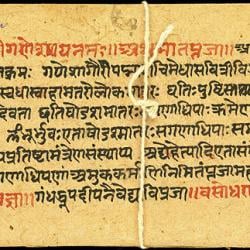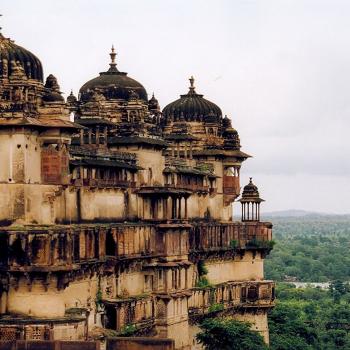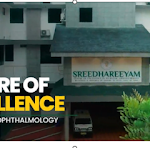The Maha Mrityunjaya Mantra is a much sort after Jaap that is said to provide eternal life and escape from death. The literal meaning of name of the mantra is: Maha means ‘great’; Mrityu means ‘death’; and jaya means ‘victory’. Thus the mantra gives one victory over death. It is also referred to as the Mrit-Sanjivini Mantra, the Rudra Mantra and the Tryambakam Mantra. The words and lyrics of the mantra are given below, along with a download link for the mp3.
Maha Mrityunjaya Mantra Mp3 Download & Lyrics
Om Tryambakam Yajamahe, Sugandhim Pushtivardhanam
Urvaarukamiva Bandhanaan, Mrityor Muksheeya Maamritaat.
MP3 Link: Right-click and Save As/>
According to Swami Sivananda, this mantra is beneficial for devotees’ health, long life, peace and happiness. He further says, “This great Mantra in praise of Lord Shiva works wonders, averts accidents, heals diseases and bestows long life. It will also liberate you from Samsara.”
The literal meaning of the mantra’s lyrics are as follows:
Om is the sacred sound that represents the fundamental sound that birthed the creation.
Tryambakam refers to Lord Shiva. It means three-eyed one, refering to Shiva’s third eye.
Yajamahe means to worship, propitiate and worship
Sugandhim means the sweet-smelling one or one who is fragrant
Pushti means to prosper or to be healthy and full of lief
Vardhanam refers to Shiva as he who confers the boon or long life, health, prosperity and fullness of life
Urva means to kill or hurt
arukamiva means disease.
Thus Urvaarukamiva means disease that hurts or kills
Bandhanaan means to bind
Thus, Shiva is the one who can release from the bounds of disease that causes death and pain.
There is another meaning for this phrase.
Urva means a peach or a cucumber
arukamiva means the stem of the fruit.
Thus Urvaarukamiva means Shiva is one who releases from the bound of death, as a fruit is liberated from its bond with the plant.
Mrityor Muksheeya means to be liberated from death
Maamritaat means “not immortality”
Thus, the phrase means, “liberate me from death but not from immortality”.
Thus, the entire meaning of the mantra is:
We bow to Shiva who is ever-fragrant and who is nourisher of all. May He free me from Death as the Urvaruka (cucumber) fruit is detached from the creeper.
More Free Stuff
 Vairagya is a collection of sacred chants that include Nirvana Shatakam, Aum Namah Shivaya and Guru Paduka Stotram.
Vairagya is a collection of sacred chants that include Nirvana Shatakam, Aum Namah Shivaya and Guru Paduka Stotram.
 “Shiva – Ultimate Outlaw” is in the words of yogi and mystic Sadhguru, and gives us a dynamic and unique look at the many aspects of Lord Shiva, that are not found elsewhere.
“Shiva – Ultimate Outlaw” is in the words of yogi and mystic Sadhguru, and gives us a dynamic and unique look at the many aspects of Lord Shiva, that are not found elsewhere.
 The Lord Shiva app is a one-stop guide to Lord Shiva. Get chants, stories, temples, wallpapers and more.
The Lord Shiva app is a one-stop guide to Lord Shiva. Get chants, stories, temples, wallpapers and more.
Download Android App
The Story of the Jaap of Maha Mrityunjaya Mantra
Markandeya is a well-known sage and is one of the immortals. His immortality is a result of his intense devotion to Shiva, which resulted in the death of Yama, the Lord of Death itself. Markandeya was to be taken by Yama on his sixteenth birthday, but the devout young boy escaped his tryst with the lord of death. This is the story.
Mrikandu was a rishi who lived in the region of Bharat, in what is now known as Tamil Nadu. He lived a peaceful and happy life with his wife, who name was Marudavati. They were devoted to Lord Shiva and prayed together, ate their meals together, and lived satisfied with what the lord bestowed upon them. However, as many years passed, they were pained by one seeming lack in their life: they had no children.
‘I wish we had a child,’ they would often sigh. Then one day, Mrikandu decided that he would seek Lord SHiva’s intervention. ‘I’m going to pray to Shiva’ said Mrikandu. ‘Will he help us?’, asked Marudavati. ‘Of course he will’ said Mrikandu.
Mrikandu left his hermitage to perform severe austerities in the deep forest. He prayed for hours and days. Many months passed and he gave up all food, living of the air. His devotion to Lord Shiva was utterly single-minded and reached intense states.
“O Shiva, Mahadeva, Lord of the world. Bless my wife and me with a child. Our desire is deep, and we have never asked anything of you before. Please fulfil this one desire of ours. O Neelakanta, the blue-throated one, please hear my plea now.”
So intense was Mrikandu’s appeal that the form of Shiva appeared before him in all his great glory. “Your devotion pleases me greatly Mrikandu,” he said. “I shall grant your wish.” Mrikandu was delighted. “But first”, said Shiva, “answer my question. Do you want 100 sons who will long lives, but will be of foolish mind and ignoble heart? Or do you want one radiant boy who will be of great intelligence and devotion, but who will die at the age of sixteen?”
“O radiant one,” replied Mrikandu. “O Nataraja, may it be the brilliant child. Though his life be short, he will make good use of it.”
“As you wish,” said Shiva, and vanished.
In time, Marudvati gave birth to a baby boy, whom the couple named Markandeya. Markendaya began to grow into a brilliant, intelligent child, eager to learn and always curious. The parents were happy that Shiva’s boon had come true. Yet, as each year went by and the dreaded sixteenth loomed closer, Mrikandu and Marudavati grew sadder and fearful. His mother wept. His father brooded. As Markandeya approached the age of sixteen, Mrikandu and his wife became quite inconsolable. ‘Why are you so sad, O mother and father?’ ,asked Markandeya. ‘Have I done something wrong?’
‘Not you, my child’, Marudvati said. ‘It is the word of Shiva that we mourn.’
Mrikandu said, ‘Sit down by me, my son, and I will tell you the story of your birth.’ And Mrikandu told his son everything including the dreaded date of the boy’s promised death. Markandeya sighed. Then he said, ‘Don’t worry. Lord Shiva is good to those who love and honour him. I will worship him at a temple upon a sacred riverbank.”
The Jaap of Maha Mrityunjaya Mantra is revealed
Markandeya prayed to Shiva. He blew his conch. He crafted a linga and circled the holy linga. He spent hour upon hour praying before it. He stopped neither to eat nor drink. He became a pavahari, one who lives on air. At dawn and dusk, he blew his conch, and around the turns of day and night, he chanted prayers to Shiva. “Blue-throated lord of time, Neelakanta, Mahakala, who are time itself, destroyer of time, I bow to you.”
On and on Markandeya chanted. It is said that the Maha Mrityunjaya mantra was revealed to him at this time, as a result of his intense austerity. He chanted the mantra repeatedly: Om Tryambakam Yajamahe, Sugandhim Pushtivardhanam, Urvaarukamiva Bandhanaan, Mrityor Muksheeya Maamritaat.
His sixteenth birthday drew closer and the time for Yama to claim his soul neared. Then, with a burst of light, Yama appeared on his huge buffalo, with his noose, the Yama-pashan. He flung the noose at Markandeya, who instantly embraced the Shiva linga. Yama’s noose fell around Markandeya and Yama pulled. But at that instant, Shiva appeared. Shiva raised his trident and with a powerful thrust, speared Yama’s heart, killing him instantly. Thus, Shiva is known as Kalakaalaya, the one who killed death itself.
With the death of Yama, all life on the planet would become immortal. The gods and deities from heaven descended to where the epic battle had taken place. They bowed to Mahadeva and requested him, “O Lord, if you kill death itself, how will the cycle of life replenish itself. Imagine the burden of everlasting life. Life without end. The living will be unable to bear it. Please give Yama back his existence.”
Shiva, seeing the wisdom of their words, Shiva acquiesced and recreated Yama again on the condition that the devout boy should receive the gift of immortality. As both Yama and Markendaya and all the gods bowed to Shiva, Shiva blessed Markandeya and granted him everlasting life. Thus it was that the Maha Mrityunjaya mantra became a part of the world through Markandeya. This story is depicted in several reliefs in many temples in India, for example the relief where Shiva saves the boy Markandeya from Death; Kala-samhara-murti at the Thanjavur, Brihadeesvara temple. Kalasamharamurti (“the Lord who destroys Kala [time]”) is described as standing with his right foot on a lotus seat, with the left raised up to kick Kala on the chest; he displays three eyes, tusks, matted hair, four or eight arms, “the right hands in the former case carrying the trident lifted up to the ear and the hatchet or varada pose, the left hands being in such pose near the navel and vismaya pose near the crown.” Kala (Yama, Time) and the boy Markandeya, the two other characters involved in this myth, are also described.
How the Maha Mrityunjaya came to be written into the Shiva Purana is told in two different stories. In the first, it is said that Chandra the moon abused and made fun of Daksha. Daksha being one of the prajapatis had the power to curse the moon and cursed him saying that he would die. But Sati saw that Chandra must not die and she requested help from rishi Markandeya. The great rishi granted the mantra to Sati, who then passed it on to the Moon. Thus, the moon waxes and wanes every fortnight, and was saved from eternal death.
In another story, it is said that rishi Shukracharya, who was the preceptor of the asuras did intense asuterities and was granted this mantra by Lord Shiva. Thus the Maha Mrityunjaya mantra also came to be known as the Sanjivini or Mrita-sanjivini mantra. From Shukracharya, it was revealed to sage Kahola, the father of rishi Ashtavakra. Kahola gavfe to rishi Dadichi, so that he could remake himself after being destroyed, so that his bones would be used to make the vajra of Lord Indra when he was fighting Vritra. From Dadichi, the mantra was revealed to King Kshuva, who is said to have placed it in the Shiva Purana.
The Maha Mrityunjaya Mantra in the Vedas
The Maha Mrityunjaya Jaap can be found in three of the four Vedas. In the Rig Veda, the earliest of the Vedas, it is found in Mandala 7, Verse 59.12. This Mandala was written by sage Vashishtha, so it is possible that the mantra was known to him. The mantra also appears in the Yajurveda, the third-oldest of the Vedas. It is found twice in this Veda. It is found in the Black Yajurveda or Krishna Yajurveda, in the Taittiriya Samhita,and in the white Yajurveda or Shukla Yajurveda, in the Vajapeya Samhita. It is also found in the last of the Vedas, the Atharva Veda in Chapter 14. The Atharva Veda was put together by Veda Vyasa and Mahaatharvan. Thus, these two great rishis were also aware of the Maha Mrityunjaya Jaap.
Possible temples where Maha Mrityunjaya Mantra was revealed
There are several temples in India where it is said that the mantra was revealed to Markandeya rishi. In most these temples, the deity is a linga and is referred to as Markandeshwara or Markandeshwarar. It is unclear which the real temple is, but it likely to be the Tirukkadavur temple in Tamil Nadu. About 12 miles to the south-east of Mayavaram, the deity of the temple is known as Amritakadesvara, who was at one time worshipped by Durga, Vasuki (Serpent-chief) and the Saptakanyakas (the celestial nymphs).
Of this temple, one the Nayanmars, Appar, said:
Resisting the charms
of women with eyes curved like the the fish,
Markandeya became Shiva’s devotee,
bathing his God every day
in streams of milk, and good yoghurt and ghee,
seeking thus to put an end to the pain of ignorant life.
It was for him that the Lord of the Virattam shrine in Kadavur once kicked at Death.
Apart from Appar, Sundarar, and Sambandar also connect this particular village to Markandeya’s story. They say:
The place of the Lord with the throat dark as a sapphire,
who kicked to death Death himself
when he came to seize
the life of the young boy
as he worshipped his God with fresh flowers.
The Supreme Lord who lives in Kadavur is the one whose foot felled with a kick Death himself,
dark-bodied god with terrible curved tusks,
fire-red hair and coiled tongue,
who had come for the boy Markandeya
as he worshipped his God
to put an end to the sorrow of ignorant life.
Markandeshwarar Temple, Puri, Orissa: This temple is situated on the bank of Markandeya Tank about 3 kilometers from Lokanatheswar Temple. The Lord adorning this temple is known as Markandeshwar. About a kilometer away is the Neelkanteshwarar temple, located on the banks of the Indradyumna Tank.
Markandeya Teertha, Badrinath: There are said to be five sacred teerthas at Badrinath, one of which is the rock of Markandeya, which is named for the ancient sage who wandered through all the tirthas of the earth to see Vishnu with his own eyes. It was here, seated on this rock, that Markandeya saw the Lord. He, too, was given a boon, and he, too, asked that Vishnu’s darshan be available to all who sit on this rock.
Personification of Death in the Maha Mrityunjaya Mantra
Mrityu ’Death’, is the personification of death. References to death in early Vedic literature make it clear that life after death was envisaged as a repetition of life on earth with ‘the whole body and all its members’ [sanatanuh sangah) being restored and capable of enjoying all the pleasures of mortal life. Despite this prospect death continued to be dreaded. This is indicated by the numerous mantras in the Atharvana Veda each designed to avert a particular disease or calamity that might result in death, and the equally numerous prayers appealing to the gods to grant longevity, i.e, a hundred years, the Vedic ideal Dreaded almost as much as death, especially by men, was old age and the loss of physical powers. Thus the need for a Maha Mrityunjaya Jaap. Apparently even the gods were originally not immune from death. Prajapati attained immortality and made his body ‘undecaying’ by a sacrificial fire or by practising austerities (tapas) for a thousand years. He also instructed the gods by means of a rite how to attain immortality. Mrityu complained that if mankind came to share this immortality he would have no food and nothing to do. Whereupon the gods decreed that mankind should only become immortal after surrendering their bodies to Death but those refusing to accept this condition must resume their earthly life, and repeatedly become the ‘food of Death’.
A bundle of twigs was tied to the foot of the corpse, thus obliterating its footsteps and so preventing or delaying the return either of Death or the deceased to the land of the living. As a further precaution the priest erected a mound of earth or stone to prevent Death’s return. Mrityu dwells in the sun, hence the world of death is the highest sky. Thus Mrityu or Yama is seen as Sun’s son, through Sanjana. The sun’s glowing light is immortal. Death does not die for he is within the immortal, and hence it is said, ‘within Death is immortality Whoever comprehends this passes after death to that body and becomes immortal, for Death is his own self.














